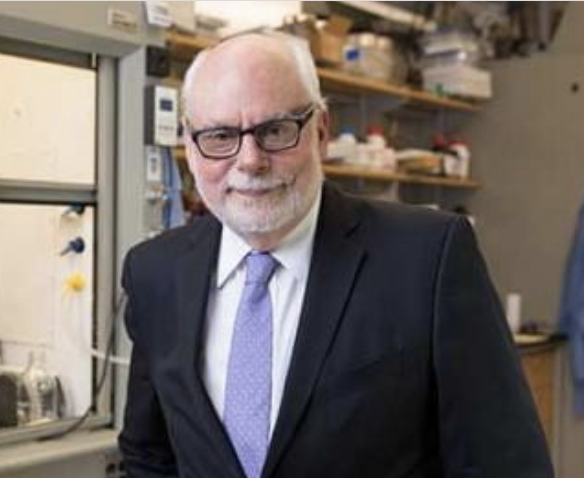Novel chemical process aims for high-energy impact
A team of Northwestern graduate and postdoctoral researchers within 2016 Nobel Laureate Sir Fraser Stoddart’s synthetic chemistry group has created a process to potentially generate high amounts of energy by mechanically bonding molecular components in molecules he developed nearly 30 years ago.
 According to “Pumps through the Ages,” a review article published this month in the CellPress journal Chem, the team’s discovery could lead to the development of larger artificial molecular machines and usher in a new field of investigation within molecular nanotechnology, says Yunyan Qiu, lead author and a postdoctoral fellow in the Department of Chemistry’s Stoddart Mechanostereochemistry Group.
According to “Pumps through the Ages,” a review article published this month in the CellPress journal Chem, the team’s discovery could lead to the development of larger artificial molecular machines and usher in a new field of investigation within molecular nanotechnology, says Yunyan Qiu, lead author and a postdoctoral fellow in the Department of Chemistry’s Stoddart Mechanostereochemistry Group.
 “The development of artificial molecular pumps — a subset of artificial molecular machines — plays an important role in the pursuit of away-from-equilibrium molecular systems and entities,” Qiu said. “The strategy will facilitate the development of a wide array of different types of molecular machines.”
“The development of artificial molecular pumps — a subset of artificial molecular machines — plays an important role in the pursuit of away-from-equilibrium molecular systems and entities,” Qiu said. “The strategy will facilitate the development of a wide array of different types of molecular machines.”
Key to this discovery was looking back at various pumps throughout history, from the syringe and steam-engine piston pumps at the macroscopic level to the discovery of biomolecular pumps within the mitochondria of living cells. Many, if not most, pumps use a positive displacement (or geometric) mechanism to move fluid from a lower level to a higher one.
By conducting this historical survey, Qiu says, the team recognized a unifying concept of geometric pumping and applied that idea to Stoddart’s famed work on rotaxanes, synthetic molecules that are created when a ring-shaped molecule called a macrocycle is mechanically “threaded” over an axle-shaped molecule. The axle’s dumbbell-like ends keep the ring component in place.
In 1991, Stoddart developed the threading process and proved the macrocycle could move between the ends, leading to a new field of synthetic molecular nanotechnology. Subsequent work by Stoddart, as well as Jean-Pierre Sauvage and Bernard L. Feringa, led to the development of several molecular machines, including switches and motors that could “perform a task when energy is added,” according to the Royal Swedish Academy of Sciences, which awarded all three the Nobel Prize in Chemistry in 2016.
Typically, rotaxanes only thread one macrocycle per axle. However, the new process — developed by Qiu and co-authors Stoddart, fellow NU researchers Yuanning Feng and Qing-Hui Guo, and molecular-machine theorist Dean Astumian from the University of Maine — uses artificial molecular pumps located at both ends of a polymeric axle to thread up to 10 rings. The findings were published recently in Science.
During the reduction process, each pump brings a macrocycle up to the axle, Qiu says. Then, using either a chemical reagent or electricity to initiate oxidation, electrons are lost, allowing the pump to thread the rings over a “speed-bump” onto a collecting chain on the axle. The number of rings depends on the number of cycles.
The molecular pump’s design was inspired by the function of a pumping cassette, an idea developed by Astumian and his coworkers in the context of explaining the effect of oscillating electric fields on biomolecular pumps. “The key idea we discussed is that of a modular unit capable of transducing energy from an external source by pumping materials from a low energy to a higher energy state,” Astumian says.
The resulting polyrotaxane can be programmed to harvest and store energy. Further, the “pumping cassette” idea could lead to other applications in the creation of molecular machines.
“The conceptual introduction of a pumping cassette, which governs the motion of movable components within molecules, will facilitate further development of artificial molecular machines that are capable of creating local concentrations of molecular components,” Qiu says, “an essential process which is often found in the biological world, but is quite challenging to emulate using wholly synthetic systems.”
Stoddart says his group has been working in this research area since 2013, when it first designed a prototype artificial molecular pump. The group would later build and test the usefulness of the pump up until early 2020, when discussions between Qiu, Stoddart, Astumian, and other researchers led to the making of the polyrotaxane synthesizer.
“The content of the review started to emerge in discussions with Professor Astumian and then incubated during numerous intense Zoom meetings between all the authors,” says Stoddart. “This was a collaboration between a theorist and experimentalists, and the give-and-take between different perspectives resulted in many, very lively conversations.”
It’s still too early to tell what real-world implications are possible for the discovery, Stoddart says, likening the use of this branch of molecular nanotechnology in the present day to the development of electric motors in the early 1800s. Says Stoddart: “It took half a century for the first rudimentary fans, food mixers and hair dryers to appear on the scene.”
Stoddart remains optimistic that other researchers will follow his team’s path and find applications for the newly minted polyrotaxanes.
“This review provides both conceptual and practical guidelines to stimulate other scientists and researchers in the related fields,” Qiu says. “By working together, we can move this relatively new field of research forward.”